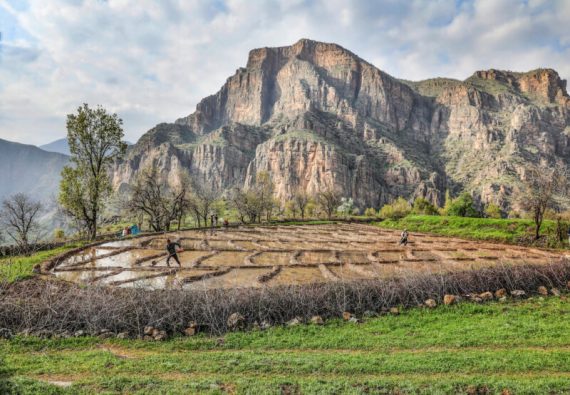I
n 1798, Thomas Robert Malthus said that the world population increases in geometric progression while the food production in arithmetic progression, and predicted that hunger, disease, death, and wars might occur due to insufficient food. However, Malthus could not have predicted the unprecedented productivity increase achieved due to the use of technology in agriculture as mechanical, electrical, biological, chemical, and digital technology has tremendously increased agricultural productivity.
Vertical and soilless agriculture has also reduced the land constraint to a certain level, and the hunger-based diseases, deaths, and wars that Malthus predicted did not occur with food production having become more than enough to meet needs. In some parts of the world, the reason for food shortage and hunger is not insufficient food production, but its ineffective distribution to the people in need.
Dilemma in agriculture
The increasing use of inputs from new technologies in agriculture contributes to a faster increase in greenhouse gas emissions. It is estimated that 17% of this contribution is directly from agricultural practices, while an additional 7-14% from changes in land use.
Agricultural greenhouse gases comprise nitrous oxide from grazing animals, tillage, fertilizer use, and urine, and methane gases produced by ruminants and rice cultivation. These gases have the potential to increase global warming at a higher rate than carbon dioxide. Therefore, agriculture is potentially an important part of both the problem and the solution to climate change.
The concept of sustainable agriculture entered the world agenda years ago with the promise of transferring natural resources and the environment to future generations in a secure way. Implementing policies that increase sustainable productivity and, at the same time, reduce input-intensive practices that cause climate change have become the priority targets.
Supporting sustainable, climate-friendly, and productive agriculture that does not harm natural resources and the environment as well as ameliorating wrong incentives at all levels have come to the fore.
In parallel with these trends, measures at the global and regional level have entered the global agenda. Policies that came into being following the United Nations Paris Agreement (2015) and the latest European Green Deal (2019) after the Kyoto Protocol (1997) regulate economic activities to protect natural resources and the environment.
The emission reduction strategies in the Paris Agreement provide the chance for agriculture and the food chain to be an active part in the solution to climate change. The Green Deal aims to end net greenhouse gas emissions in Europe by 2050. However, these limitations are approached with suspicion due to the COVID19 pandemic and the food insecurity that emerged following the Russia-Ukraine War.
Conventional vs. sustainable agriculture
Let’s start by taking a closer look at sustainable and conventional agricultural practices. Sustainable/organic agriculture aims to produce crops without the use of synthetic chemicals or fertilizers, while at the same time providing appropriate soil composition and biodiversity. Sustainable agriculture is a more enduring type of farming that relies on ecosystem services to maintain the integrity of the ecological environment and to achieve sufficient yields. Conventional agriculture, on the other hand, typically uses synthetic chemicals and fertilizers to maximize the yield of genetically enhanced crops and animal products. This method requires significant chemical and energy input and weakens the landscape’s ecology.
Conventional agriculture often alters the natural environment, degrades soil quality, and reduces biodiversity. When first initiated, it was to make farming more efficient; however, this happened at a high cost to the environment. Conventional agriculture endangers ecosystem balance, biodiversity, and soil fertility, and mostly involves monocropping, making it easier for the farmers.
A single crop is ideal because it reduces labor costs and is easy to harvest, but it can also negatively impact biodiversity. In a conventional system, farmers can apply pesticides and herbicides to crops at a much more efficient rate if they grow a single crop; however, this does not protect environmental health and biodiversity.
Conventional agriculture represents one end of agriculture, while sustainable agriculture represents the other. Sustainable/organic agriculture is a production system that emphasizes the health of soils, ecosystems, and people. Based on ecological processes, biodiversity and natural cycles adapted to local conditions. Thus, rather than the use of inputs with adverse effects, organic farming combines tradition, innovation, and science.
Sustainable agriculture is a more holistic approach to farming than conventional agriculture, as it relies on ecosystem services and causes much less damage to the land used. It is a natural way of producing food and provides a range of social, economic, and environmental benefits.
Which agriculture – sustainable, good, ecological, natural, or organic?
Sustainable agriculture is given different names with slightly different meanings such as good, ecological, natural, or organic. In fact, all refer to agriculture that minimizes or completely removes synthetic inputs from the ecosystem. However, there are differences between them. Good agriculture refers to agriculture that does not harm health, animal welfare, or the environment, and uses only necessary chemical inputs such as fertilizers and pesticides at the lowest level to ensure that chemical residues do not penetrate the product.
Natural and ecological agriculture can be defined as growing in a natural environment, where no chemicals are used. Organic agriculture refers to the agriculture with a certification process, which rejects the use of any chemical at every stage from production to consumption. However, the concepts of natural, ecological, and organic farming are often used interchangeably.
In sustainable agriculture, farmers combine a variety of crops to provide biodiversity and prevent pests and pathogens, rather than using synthetic pesticides, herbicides, and fertilizers to produce food. While conventional systems promote uniformity, and depend on synthetic chemicals for protection against disease and pests, sustainable systems rely on biodiversity as a safeguard against these risks.
Preventive agriculture works too
One of the sustainable agricultural practices that emphasizes economic benefits and environmental health is preventive agriculture. By increasing the organic matter content and moisture holding capacity of the soil, it can double the subsistence crop yield in areas where the use of fertilizers is not economical and sustain production in low rainfall years. Preventive agriculture focuses on producing high yields without compromising environmental integrity.
The organic farming practices of the Amish people in the U.S. states of Pennsylvania and Ohio are examples of preventive agriculture. Utilizing the power of horses instead of tractors and mostly engaging in organic farming away from chemical inputs, the Amish produce more productive corn than the farms in the vicinity that use chemicals by providing organic matter and moisture accumulation in the soil.
Comparison of conventionality and sustainability
A comparison of conventional and sustainable agriculture could be made in terms of (1) production, (2) biodiversity, (3) soil composition/erosion, (4) water use, (5) energy use, and (6) greenhouse gas emissions. The environmental impact and production levels of each method determine its overall applicability as a solution to emerging trends.
It is necessary to make these comparisons to determine the best farming method that can sustainably meet the needs of the current population. Although these comparisons are based on scientific data, studies that consider local conditions in detail are needed to make a definitive judgment.
Conventional agriculture, despite its detrimental effects to the environment, is a viable way to provide food for more people. Population growth and the increasing consumption of high-calorie and meat-intensive diets are expected to double human food demand by 2050. Production levels become a serious benchmark for this rapid growth. Organic yields might be on average 25% lower than conventional yields globally, but varying by crop and farming system, according to a recent meta-analysis, is much better in the long run. For example, under drought conditions, organic farming tends to produce higher yields because of more water retained in the soil. Although production levels decline in sustainable agriculture, research shows that higher biodiversity levels are linked to healthier crops.
Biodiversity plays a big role, as it is a determinant of healthy food and performance. The greater the biodiversity, the more immune the plants are to pests and diseases. This is important because conventional agriculture discourages biodiversity and instead uses synthetic chemicals to maintain the health of crops.
More than 500 million liters of pesticides are used annually, of which only 10% reach the desired target. These figures could be greatly reduced if conventional agriculture implements sustainable alternatives. Techniques such as integrated pest management and good agricultural practices can be applied to conventional agriculture and thus promote biodiversity.
Despite the negative effects of conventional methods on farmland, not all conventional farms degrade biodiversity. By applying low input alternatives, farmers can reduce the amount of chemicals and energy they use. In addition to higher biodiversity levels, sustainable agriculture is associated with good soil quality. Organic farms have stronger soil ecology because they care about biodiversity rather than uniformity.
A study in Italy compared two adjacent farms, one organic and one conventional, and found that areas under organic management showed significantly better nutritional and microbiological conditions. These conditions increased total nitrogen, nitrate, phosphorus, and microbial biomass content, and enzymatic activities.
Soil and water matter
Soil management is vital to existing farms, as agricultural production is increasing globally and less land is being put to use to accommodate this growth. Conventional systems can slightly increase land supply with agroforestry to alleviate this problem.
Soil erosion threatens the future sustainability of agricultural production on a global scale, especially under extreme climatic events such as drought. Organic systems improve soil composition by creating more plant material and biomass in the soil, thus preventing soil erosion.
On a global scale, water is a renewable resource that meets the needs of the world’s population. However, water is a scarce resource locally and must be allocated efficiently. Agriculture accounts for about 70% of water use worldwide. Increasing demand for freshwater is putting pressure on global stocks. To protect this resource, a drastic change of water conservation techniques must occur, especially in agriculture.
Recommended
Because of the abundance of flora and fauna in sustainable systems, organic soil typically holds much more water than conventional soil. This increased retention rate enables sustainable farming to produce much higher yields in drought conditions than conventional systems. To manage water resources, sustainable agriculture is a more effective approach to feeding world.
Conventional agriculture requires an incredible amount of energy to produce, prepare, and transport food. Energy efficiency is important for agriculture as it can reduce greenhouse gas emissions and provide lower production costs. Agriculture is responsible for a significant percentage of greenhouse gas emissions, but it can also reduce this impact by using sustainable methods.
Sustainable agriculture is very effective at reducing greenhouse emissions compared to conventional agriculture because it does not require the input of synthetic chemicals or fertilizers that generate large amounts of greenhouse gas emissions. Although conventional systems yield more than sustainable farming, organic crop production is the most energy efficient method.
Studies point to sustainable agriculture as the best solution to manage the growing population. Although the benefits of sustainable agriculture are many, there are several limitations to adopting this method worldwide. While sustainable agriculture is the most efficient system in one part of the world, it may not be completely viable in another.
In the case of pest control technologies, for example, it is recommended to adopt integrated farming rather than just supporting organic practices. Many factors determine the performance of farming methods, and often the most effective type of farming requires a combination of techniques. In addition to local restrictions, sustainable agriculture requires more effort to preserve crops.
Water, energy, and land are three important factors that determine the survival of the world’s population, and it is crucial that they are used as efficiently as possible. Comparing sustainable and conventional farming, organic farming methods perform much better for a number of indicators. Sustainable agriculture consumes less water and energy, improves soil composition, and forgoes synthetic chemical input.
Conventional agriculture cannot meet the needs of the current population without compromising environmental integrity. Sustainable agriculture has the potential to absorb carbon, feed the world, and enrich the environment. Its social, economic, and environmental benefits are the reasons why sustainable agriculture is the most appropriate way out.





